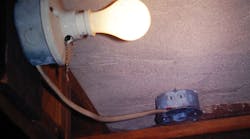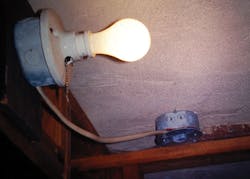How well do you know the Code? Think you can spot violations the original installer either ignored or couldn’t identify? Here’s your chance to moonlight as an electrical inspector and second-guess someone else’s work from the safety of your living room or office. Can you identify the Code violation(s) in this photo? Note: Submitted comments must include specific references from the 2011 NEC.
Hint: Hungry box
‘Tell Them What They’ve Won...’
Using the 2011 NEC, correctly identify the Code violation(s) in this month’s photo — in 200 words or less — and you could win a $50 gift check. E-mail your response, including your name and mailing address, to [email protected], and Russ will select three winners (excluding manufacturers and prior winners) at random from the correct submissions. Note that submissions without an address will not be eligible to win.
July Winners
Our three winners this month were: Ken Kohler, project manager, Best Electrical Services, Chester, Md.; Michael S. Groff, lead electrical designer, Air Products and Chemicals, Inc., Allentown, Pa.; and Thomas Sessa, electrical engineer, U.S. Army Corps of Engineers, Electrical Section, New York. They were all able to correctly cite the violations associated with this tight-fit plumbing and electrical installation.
We can only hope the electrician completed his work before the plumber showed up to install this water pipe. Any qualified electrician knows it’s a violation to have the water pipe directly in front of this panelboard. The plumber on the other hand… well, the photo speaks for itself.
The winners correctly identified working space violations at this panelboard. Section 110.26(A) establishes the minimum clearances required for working space. The minimum depth needed in front of the panel, according to Table 110.26(A)(1), is required to be at least 3 ft. The minimum width would need to be at least 30 in., in accordance with 110.26(A)(2). The working space in front of this panel should be clear and extend from the floor to a height of at least 6½ ft, or to the height of the equipment if it is taller than 6½ ft. This pipe was jammed so close to the panel that the panel door could not be opened enough to even flip a circuit breaker.






